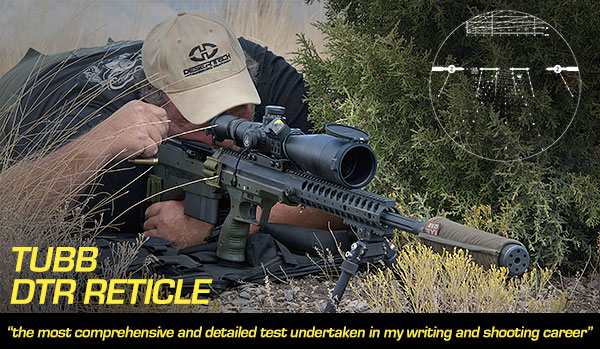
While controversial, David Tubb is one of the winningest competitive rifleman around and an accomplished worldwide hunter. He has won 11 NRA High Power Championships along with 30 NRA Silhouette Rifle titles. He has another 6 Long Range Rifle National Championships and two Wimbledon Cups. His competitive and hunting resume is impressive and his contribution to the precision rifle industry more so. He has brought numerous rifles, parts, and accessories to market that have changed the industry. His rifles have won numerous competitions and titles. David is always thinking outside the box. One of those innovations is his DTR reticle. Designed to facilitate first rounds hits without (or with) the use of electronic assistance the reticle is simple and precise. People seem to love or hate it; time to see for myself.
Dynamic Targeting Reticle (DTR)
Calibration is based on BC (Ballistic Coefficient) and Velocity so similar projectiles will work. It includes ranging scales and a chart to determine Density Altitude (DA). Wind holds are graduated in 5 mph increments along with leads for moving targets based on speed. Etched on your scope bell is an Angle Firing template to compensate for angles. Knob covers include other information. A companion program for your phone is provided to adjust for atmospheric conditions and velocity.
Unlike most BDC reticles the DTR is precise including elevation holds compensating for gyroscopic effects on the x (horizontal) and y (vertical) axis with or without wind. In theory its as close as anyone has come to a point and shoot reticle for precision applications.
Available in either a Leupold Mark 6 3-18 x44mm or Mark 8 3.5-25x56mm scope, they are unique in design and function. Calibrated for various calibers/bullets, there are 5 total versions. Each uses markings that are graduated and marked in yards (or meters) rather than Mills or MOA.
Mark 6 Options (can be illuminated or not):
- V1 (or VIMTR –metric) Calibrated for 155, 168, and 175 grain 30 caliber projectiles.
- V1SBR Calibrated for short barreled 30 caliber.
- V2 Accommodates 6mm and some .338 Lapua and heavy 30’s.
- V3 Calibrated for 77 grain 5.56mm.
Mark 8
- Only one reticle, the V2 is available for the Mark 8 and it includes illumination.
The Review “Project”
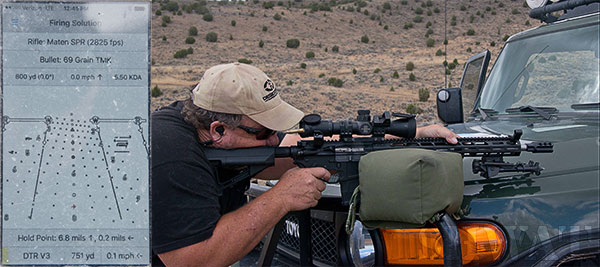
David Tubb draws substantial attention – both positive and negative. It’s common among innovators in the firearms industry. Having seen the same thing with the likes of Bill Wilson, Mark Larue and John Paul (JP Rifles), and others, it puts him in solid company. I wanted to give his reticle a fair and thorough test not just a drive by review so it took time and lots of effort.
This test has been progressing for close to a year using a Mark 6 (3-18) with a V3 reticle and a Mark 8 (3.5-25) using the V2. The Mark 8 was tested using my Desert Tech SRS A1 in five different calibers. It’s been used on established or ad-hoc ranges in 7 states. Density Altitudes ranged from sea level to 10,500 feet. Weather conditions varied from 100 degrees to 15 below zero. It’s the most comprehensive and detailed test undertaken in my writing and shooting career.
The Premise
My introduction to the DTR occurred while training with Chase Stroud of Pump Precision Rifle Training. Chase is a hunter and top tier PRS (Precision Rifle Series) competitor who excels at long range. My primary purpose was PRS training, but we hunted hogs at long range also. After discussing how Chase used his DTR for hunting and competition it prompted a thought. It seemed a perfect match for a precision rifle with caliber/barrel interchangeability. Match the characteristics of the reticle and you could apply precise fire under numerous conditions. Carrying such a rifle in a small caliber like a 6.5mm, you could quickly convert to a 338 Lapua or Norma if necessary.
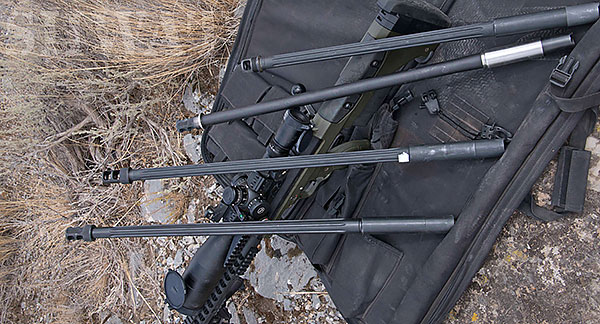
Chase let me use his reticle and gave David Tubb a call. Tubb approved of my test idea so Leupold was contacted. Both a Mark 6 and Mark 8 were in my inventory and were sent to the Leupold Custom Shop for a reticle change. Both were older scopes so it meant my Mark 6 had pinch and turn knobs and the etching on the bell was missing, but otherwise it was just as would be ordered from David Tubb Shooting Sports.
Test Rifles
Nick, the owner of Desert Tech is a long time friend and has provided solid support for previous tests. My SRS had a couple of barrels making it an obvious choice. Its primary barrel is 6.5 Creedmoor and a 338 Lapua was still around. Nick provided a barrel in 260 Remington and sent the last 338 Norma Magnum he had in stock.
Given its popularity in the PRS, a 6mm Creedmoor was in order. I contacted Rob Wilkinson from Special Purpose Rifles for assistance. Rob is a local shooter who competes in PRS matches at national events. He runs a small shop catering to precision rifle shooters. He is very familiar with the SRS and was able to provide a 26” barrel for testing.
Spuhr Mounts are tough as nails and rock solid, perfect for this project. Hakan supplied a 35mm mount for the Mark 8 and one for the Mark 6. Also provided were accessory rails for an Angle Cosign Indicator (ACI) and a couple Red Dot Sights. Mounted to the SRS, my Burris Optics FF3 was used for spotting long range targets.
Silencerco Weapons Research provided a Radius weapon mounted rangefinder. Desert Tech’s drag bag designed to carry a spare barrel was used along with their 338 caliber Suppressor. Hornady sent their new Iron Press Single Stage Loading station fully equipped along with dies and other reloading equipment to support the project.

For the Mark 6 I wanted to use an AR capable of reaching the limits of the new Black Hills Ammunition 77 grain TMK. Having used it at several Follow Through Consulting scoped carbine classes, I can say it’s impressive at long range. Two ARs were assembled for the test. The first used Seekins Precision SP15 receivers and an 18” Larue barrel I had from an older project. The second was assembled using Mega Arms receivers and a Wilson Combat 18’ 1-8 twist fluted barrel. Both used mid-length gas systems and 5.56 NATO chambers.
Testing the DTR Reticle
Initial range testing consisted of shooting each caliber from 100-1280 yards (1000 yards for the AR). I started by matching hand loaded ammunition to the reticle in everything but the 338 Lapua. Using the phone program, each was reverse engineered based on my ranges, DA (Density Altitude) and bullet characteristics. The program provides the optimum muzzle velocity to match the reticle.
Each load was worked up to within 50-100 FPS while staying within safe pressure limits. Using a MagnetoSpeed V3 velocities were confirmed over 20 round strings for consistency then tested using the reticle at each range. Targets from 100-800 yards were 12” round steel. Steel at 1000 yards was 24’ x 16” and the 1280 was 24 x 36 inches.
Factory loads were tested similarly. Federal Premium 142 grain GMM in 260 Remington was used for the non-electronic methods with the Desert Tech, Remington 77 grain OTM Match in the AR.
Several brands and calibers were tested while using the phone program. Enter your rifle information, then bullet data. Get your DA (Density Altitude) from a Kestrel or phone inputting it along with muzzle velocity. Put your range in and it provides a picture of the reticle with a red + showing your hold. You also get a chart providing holds in mils (or moa) at various ranges and density altitudes. It’s fast, simple and easy to use.
Range tests consisted of first round hit attempts at various known ranges followed by five shot strings on the same target. Back country shooting included ranging a natural target like a rock and using the scope, or scope and phone combination, to get data. Where possible my portable steel target was used.
Both rifles went with me on every media or training trip possible. Driving to most events it was possible to stop at public ranges or open space to conduct the same test. Shots were taken in Utah, Nevada, Arizona, Colorado, New Mexico, Washington, and Idaho. Ranging was completed using either a Bushnell Elite Tactical Fusion 1 mile set of Binoculars, the Radius from Silencerco or internal scale. A 12 x 16” steel target went with me on every trip making setup on the fly pretty easy and use of the scales in the reticle possible.
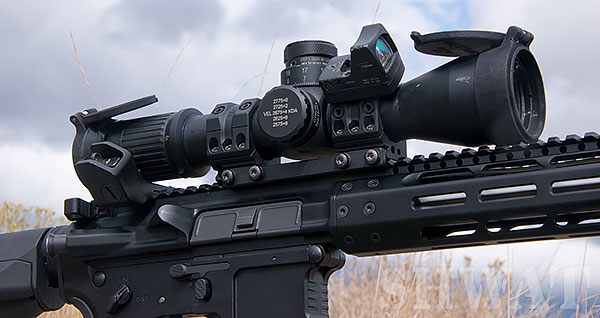
Most testing with the AR was completed using factory 77 grain match loads. Black Hills Ammunition 69 and 77 grain TMK was were extensively as was Barnes 85 Grain OTM. Early testing was completed on the Seekins and I switched to the Mega Arms build for the last few months. The rifle would come out of the bag and a target ranged or known was engaged. On occasion the phone software would be consulted, but not as a rule. The idea was to make it as point and shoot as possible at reasonable range. Remove from the bag, range, read the wind, hold and press. Watch for misses, then adjust. It was all about simplicity and speed using a carbine that was always there. First round hits were the goal.
I am not much of a “data” guy, but more of a just-pull-the-trigger-and-get-the-job-done guy. Math was never my strong point and I detest the incessant focus on mills and moa. After all the preliminary testing it was about shooting and hitting in as varied conditions as possible, not a math lesson. It either works or not. If it requires 8 hours of lecture it’s a waste of my time. What follows are my results.
DTR Accuracy and First Round Hits

There are no crosshairs in this reticle, holds are dots, numbers or shapes. It is zeroed using a single dot above the horizontal line. Several “experts” told me it would be impossible to shoot groups with accuracy. I’m not sure if they just never used the DTR, or possessed limited skill outside crosshairs. My experience was different. Some of the groups at 100 yards were the best ever produced using my rifles. A few at 300 yards were similar. My SRS is incredibly accurate, the DTR did not change that. Using the Special Purpose Rifles 6mm CM barrel, my best group was just over .20 inches. Most were between .30 and .50 inches across all calibers. This reticle has some limitations, accuracy and the ability to shoot groups or center punch the .25 inch dot at 100 yards or 3” circle at 300 yards is not one of them.
First round hits was this reticles design purpose. The closer your bullet matches the easier that is. Loaded with 69 grain TMK at 2850 fps the V3 is a virtual match at 6000 feet out to 600 yards. Moving to Washington state, closer to sea level the 77 grain TMK was almost perfect. Prior to a training in Mattawa, Washington the Mega build walked out to 800+ yards without a single miss using this combination.
Using the 260 Remington or the 6.5 CM 26” barrels and 130 grain Berger Hybrids at 2950 fps yielded similar results with the Desert Tech and V3 reticle. PRIME Ammo 130 grain was almost identical in 260 and close in 6.5CM. Both were point and shoot out to 1280 yards at my DA. It was close at other elevations.
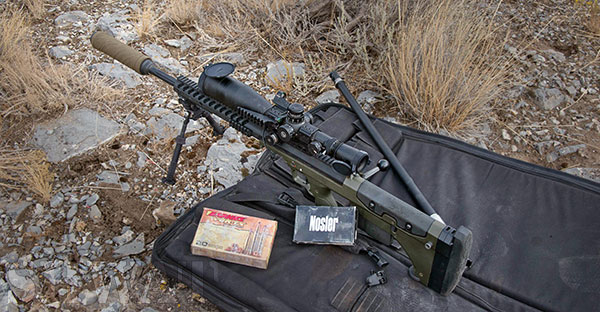
First round misses were close yielding a second round hit almost immediately. You get just a bit more juice with the 260, but not much. Looking for a fast 6mm the 6 Creedmoor was excellent. Copper Creek 115 grain DTAC and 105 grain Hybrids were very close at my elevation, just had to hold low on target. Hand loads were similar. Move to sea level and it was a perfect match. Zero recoil, laser accuracy, just a bit problematic in real wind at 1000 yards plus.
In larger calibers my 300 Norma load using 300 grain Bergers at 2750 was close to perfect out to 1300 yards. Corbon Ammunition 300 grain SMK load was close out to 800, after that the Berger’s BC really took hold. Some of the 250 grain Lapua loads were excellent with velocities in the 2900 – 3000 fps range.
Where bullets did not match the phone software proved useful. Equipped with a Kestrel and known muzzle velocity first round hits were regular. Input the data, hold where it says, add wind, bang. Use the table feature as the conditions change.
Without electronics it could be difficult, especially at long range. Slower bullets were the most difficult. If you are going to use the reticle without matching the bullet use the phone software. You can use scope features with a known muzzle velocity too. It’s simple math, but still math. In a pinch it works. It’s great if you are limited to issue ammo and land in a different country every deployment. For the rest of us, if you want first round hits use ammunition that matches the reticle. If not, have the phone handy or shoot it enough to know your holds.
Ease of Use
Every time the DTR reticle was discussed someone piped up with “its too busy”. Compared to a simple crosshair or lined reticle it is, just like most reticles this precise. I use TReMoR reticles constantly and this is no worse, in fact it is less busy. Its different, but not any more cluttered than the T2, T3 or H59. Leave hormones or marketing deals out of the equation and they are about the same. Find a line, number, mark, or figure and hold it on target. If you know how to use them they all work.
The 12” ranging scale works the same. Milling in the DRT can be done, but its not designed for that. If you live and die by mills or moa there are better choices. If you match your load, or use the software it’s very easy to use. No matter what’s used you need to true your rifle and know your muzzle velocity. Plug it into a computer or phone, read what it tells you, read the wind, aim, hold, press. It does not get any easier, just different ways to accomplish the same task.
Final Thoughts on Tubb’s DTR Reticle
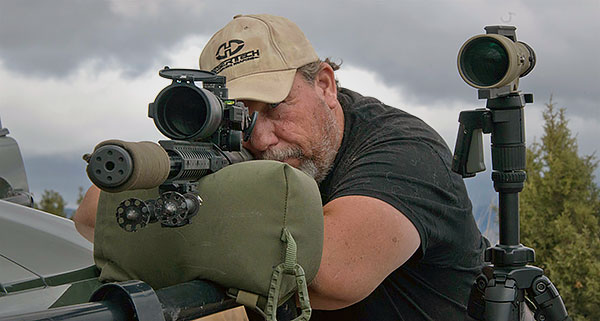
You can use the DTR by turning knobs, just not sure why you would. The idea is to leave them alone except to zero your rifle. It comes with interchangeable caps for the V2 for a different caliber I never used. It was easier for me to know where each caliber zeroed, change as needed and go to work.
David Tubb designed the DTR to be used with no ballistic computer or drop card. Given a muzzle velocity and DA you can do it all with the scope. Not sure that would happen in my world but it was designed for an SMU. I just used the Kestrel and phone. Add the Silencerco Weapons Research Radius and it was boringly simple. Remove rifle, find target, range target, find number, read wind, press trigger, hit target. It was that simple time and time again all over the Western United States at every range and in any weather condition.
Getting your scope level is CRITICAL!! Scopes come with a level, use it or another one. Spin drift and cross wind jump are built in, so cant the scope and you will miss at long range. Most long range shooters know this, but it is a must with this system. For me it is range, read the wind, hold, check level, press.
Both Tubb’s DRI (Direction Reduction Indicator) and an Angle Cosign Indicator were used for angles. The DRI is easier, in fact it was moved to my competition rifle. It tells you what to hold low in yards based on 600, 900, and 1200 yards. Just cut the numbers in half as needed, no calculator required. Since angle shooting is rare it was not used often, but the DRI works and it is fast. On a hunt it would be my first choice.
My original premise proved out well. The AR stays loaded with 69 grain TMK and is tested every few days out to 500 yards and remains dead on. Travel to sea level and the 77 grain is used with the same results. My SRS sits ready using the 260 barrel and Nosler 120 grain BT for coyotes and hogs. A .338 Lapua barrel and bolt sit in the bag with two magazines full of Double Tap Ammunition 250 Grain Accubond for bigger critters. Both yield first round hits out to 1000 yards on my 12’ x 16” steel. Barrels have been switched with the same results. Swap the barrel, change to the proper zero, range, read the wind, hold and hit – mission accomplished!
Bottom Line
If there is a drawback it’s the cost, but that’s true of everything these days. Limited to Leupold’s top tier scopes you are looking at three grand for the Mark 6, five for the Mark 8. For most willing to load these calibers that is the norm, but it is not for your budget build.
Does it work? Yep, it works well in fact. Does it take some practice? Sure like anything else. Complicated? Not really. Don’t let the instruction manual scare you, scan through it and hit the range it becomes simple when used. Chase Stroud has won PRS matches with it so it works for him. Of course it’s not for everyone, but it is simple, fast, and nets first round hits with less effort than some other options. They worked well enough that neither of these scopes will leave their respective rifles; it’s just too easy to get hits at range. Thanks to the versatility of the Desert Tech SRS, the basic idea of two barrels will get tested in a few other calibers including 300 Norma. More importantly it is time to get back out to Texas and tag some hogs at long range!
Author Dave Bahde completed a storied career as a police officer. Today he is a full time gun writer, trainer at the legendary Gunsite Academy, hog hunter and friend of SHWAT™. Have a story to share? Contact Us >>>



For changing density altitudes and/or velocity variations, there is the need to hold to a different yardage than you’re actually shooting… we worked with one of these today, and being new to the reticle didn’t realize what was happening with the very high misses at 800 to 1100 yards (6mm XC and 115 DTAC’s)… the load chronographed at 3047 fps, and this was Tubb produced ammo… but we think it should have been going a little over 2900 fps for the reticle to be correct. We coincidentally were at 4000 ft DA, the default DA for the scope this client had… we ended up using a 25 fps = 1000 ft DA variance and the “lazy numbers” on the reticle to calculate new holds based on the higher velocity we were getting. With about 125 fps extra velocity, we used 5000 ft additional DA (simulated 9000 ft DA now), and that means multiply the “lazy number” –the number on its side at each hold-over line–by 5, for 5000 ft DA shift, equivalent to 125 fps more velocity than we should have had. At 1100 yards, 5 x 9 (nine being the lazy number) is 45, so you deduct 45 from 1100 and shoot on the 1050 line. It worked well, but of course this means you’ll be jumping through some hoops–something you wouldn’t want to do under stress. I recommended getting the ammo slowed down to work better with the reticle… but it was *supposed* to have been matched to the reticle at just over 2900 fps. Mr. Magneto-speed said 3050ish however. And even if velocity is correct for the reticle, with significant DA shifts, some finagling of the long range holds will still have to be employed. Perhaps tweaking the closer range zero a bit once you pass a certain range would fix most situations… So that was our experience, maybe there are easier ways to tackle the problem… but that (according to our client) was what the instructions recommended for velocity alterations. 😮
That’s not light reading, but seems pretty accurate. The article’s author used the program you get with the scope that goes on the phone. Enter data, read hold, put on target and it works. This comment above seems to focus on doing all the work in the reticle. There’s more than one way to skin a cat…